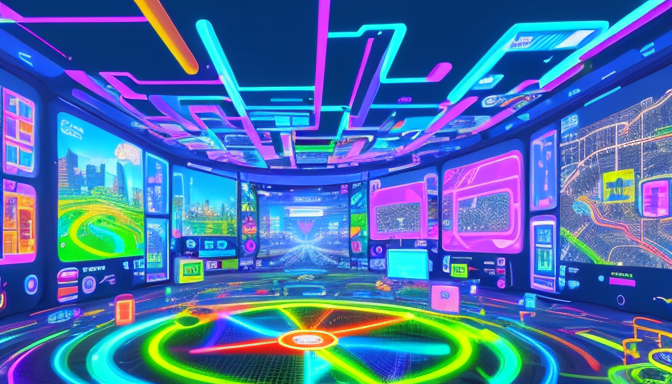The digital landscape is transforming at an unprecedented pace, and at the forefront of this revolution are virtual worlds. Imagine stepping into a realm where the boundaries of reality blur, where you can interact with others, explore fantastical landscapes, and create your own adventures. This is not just a dream; it’s the metaverse, a convergence of virtual reality (VR), augmented reality (AR), and immersive experiences that are reshaping how we engage with the digital world.
Historically, virtual worlds began as simple text-based games, but they have evolved into complex, interactive environments that captivate millions. Today, platforms like Second Life and Roblox allow users to create, share, and monetize their experiences, effectively turning players into creators. The rise of VR headsets has further enhanced this experience, making it feel more real than ever before. With each advancement, we inch closer to a fully immersive digital existence.
But what does this mean for us? As we navigate through these virtual landscapes, we must consider the impact on our social interactions. Are we fostering genuine connections, or are we merely replacing face-to-face conversations with avatars? The potential for community building is immense, yet it raises questions about authenticity and emotional connection. As we dive deeper into these virtual realms, we should remain mindful of how they influence our relationships, both personal and professional.
The Evolution of Virtual Worlds
The journey of virtual worlds has been nothing short of extraordinary. From the humble beginnings of text-based games like MUD in the late 1970s, where players interacted through typed commands, to the breathtaking landscapes of today’s metaverse, the evolution is remarkable. Imagine stepping into a realm where reality and digital experiences intertwine seamlessly—this is the essence of modern virtual worlds.
As technology advanced, so did our ability to create immersive environments. The introduction of Virtual Reality (VR) and Augmented Reality (AR) has transformed how we perceive and interact with these worlds. With VR headsets like the Oculus Rift and HTC Vive, users can step into entirely new dimensions, experiencing adventures that feel incredibly real. Meanwhile, AR applications such as Pokémon GO have blended the digital with the physical, allowing players to engage with their surroundings in novel ways.
But what does the future hold? As we look ahead, the concept of the metaverse is gaining traction, promising a fully interconnected digital universe. This evolution is not just about gaming; it encompasses social interaction, commerce, and even education. For instance, companies are exploring virtual offices where employees can collaborate in a shared space, regardless of their physical location.
In essence, the evolution of virtual worlds reflects our ongoing desire for connection and exploration. As we continue to push the boundaries of technology, the possibilities are endless. So, are you ready to dive into this new frontier?

The Impact on Social Interaction
In today’s fast-paced digital age, virtual worlds are revolutionizing the way we connect with one another. Imagine stepping into a vibrant, immersive environment where the boundaries of reality blur, and your interactions are not limited by geography. The rise of the metaverse, along with advancements in virtual reality (VR) and augmented reality (AR), is transforming social dynamics in ways we never thought possible.
These developments are creating new avenues for social interaction, allowing individuals to forge connections in a shared digital space. Whether you’re attending a virtual concert, collaborating on a project in a 3D workspace, or simply hanging out with friends in a digital café, the possibilities are endless. It’s like having a global community right at your fingertips, where you can meet people from all walks of life.
However, this shift also raises some important questions. Are we losing the essence of face-to-face communication? While virtual interactions can feel authentic, they often lack the nuances of in-person conversations. To illustrate this, consider the following:
| Aspect | In-Person Interaction | Virtual Interaction |
|---|---|---|
| Body Language | Rich and expressive | Limited interpretation |
| Emotional Connection | Immediate and tangible | Can feel distant |
| Accessibility | Geographically restricted | Global reach |
As we navigate this new landscape, it’s essential to embrace the benefits of virtual worlds while remaining mindful of their limitations. Are we ready to redefine what it means to connect? The answer lies in how we choose to blend our virtual and real-life interactions, ensuring that we maintain meaningful relationships in both realms.
Frequently Asked Questions
- What are virtual worlds?
Virtual worlds are immersive digital environments where users can interact with each other and the surroundings. Think of them as a blend of video games and social media, allowing for real-time communication and collaboration in a fantastical setting.
- How have virtual worlds evolved over time?
Starting from simple text-based games in the 1970s, virtual worlds have transformed into rich, interactive experiences. Today, they feature stunning graphics, complex narratives, and social dynamics that mirror real-life interactions, making them more engaging than ever.
- How do virtual worlds impact social interactions?
Virtual worlds are redefining how we connect. They create new communities and foster relationships that may not be possible in the physical world. Imagine meeting friends from across the globe, collaborating on projects, or even attending events together, all without leaving your home!
- What should I know before entering a virtual world?
Before diving in, it’s essential to understand the platform’s rules and community guidelines. Also, be aware of privacy settings and how to protect your personal information while enjoying the immersive experience.